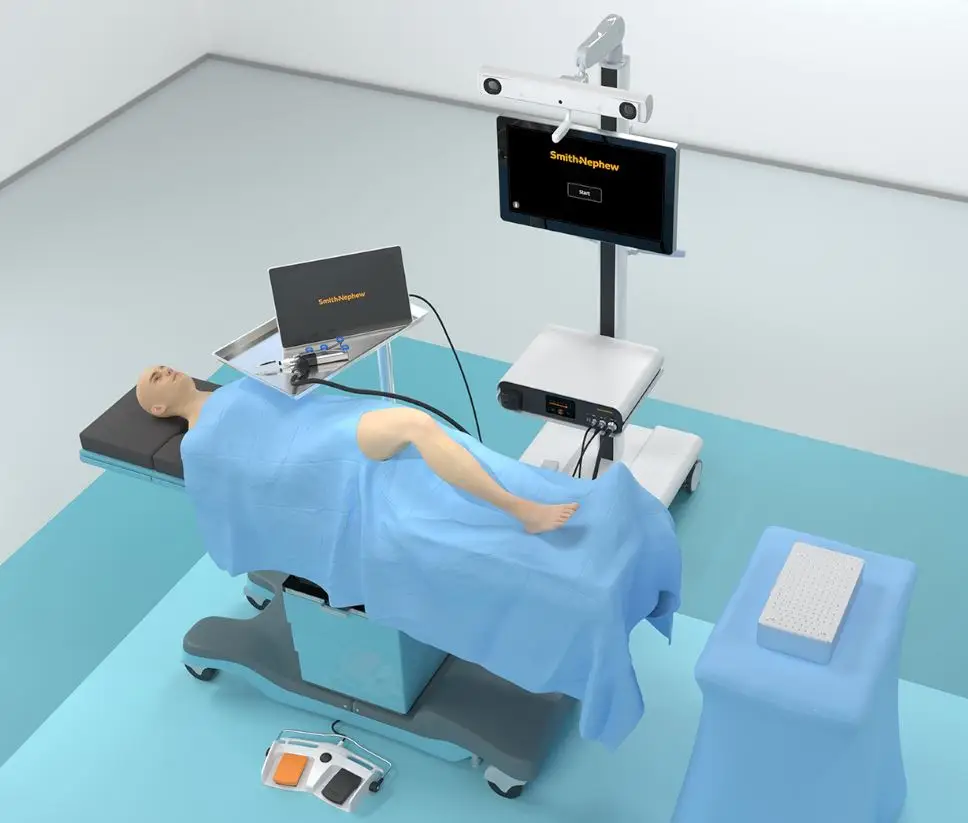A Patient’s Guide to Total Knee Replacement.

To better understand the knee’s architecture and function and the degenerative changes associated with arthritis, this post has been compiled to assist you in getting ready for total knee replacement surgery and give instructions for post-operative care. Total knee replacement surgery aims to improve your quality of life by eliminating your pain, allowing you to return to your regular activities, and restoring your knee’s functionality. Anatomy and Function of the Knee The three bones that comprise the knee joint are the femur (thighbone), the tibia (shinbone), and the patella (kneecap). The knee may be described as a modified hinge joint, similar to the hinge on a door. However, the knee bends back and forth like a hinge and has a complex rotational component that occurs with flexion and extension of the knee. The knee is a more weight-bearing joint held together by muscle ligaments and other crucial soft tissue. Cartilage is the material inside the joint that provides shock absorption to the knee during weight-bearing activities such as walking or stair climbing. The Arthritic Knee Arthritis in the knee joint occurs due to degeneration of the cartilage in your knee. Osteoarthritis is commonly called “wear and tear arthritis” or degenerative arthritis and is the most common cause of total knee replacement surgery. Due to osteoarthritis, the cartilage in the knee breaks down time, resulting in a severely damaged joint surface with bone rubbing on the bone. This process may occur due to previous trauma to the joint, ligament instability, or abnormal stresses to the joint. Rheumatoid arthritis is an inflammatory process that results in erosion of the articular cartilage and subsequent damage to the knee joint surface. Non-surgical Treatment of the Arthritic Knee Listed below are several non-operative, conservative options to consider for the treatment of the arthritic knee: Lifestyle Modification: Losing weight, avoiding aggravating activities, modifying exercise to low-impact activities only. Exercises: Specifically prescribed exercises to improve strength and flexibility without exacerbating pain. Anti-inflammatory Medications: Designed to decrease swelling in the joint and provide temporary pain relief. Corticosteroid Injection: Powerful anti-inflammatory agent injected directly into the joint. 5. Joint Fluid Therapy: A series of injections directly into your knee, designed to improve lubrication in the joint. Glucosamine/Chondroitin: Dietary supplement that may relieve arthritic pain. Bracing: Used to provide external stability to the knee joint. Arthroscopic Surgery: Minimally invasive procedure to remove debris or repair torn cartilage. Reasons for Knee Replacement Surgery Total knee replacement surgery is considered when all other conservative measures have failed to provide successful intervention and may be performed for the following reasons: To relieve pain To improve joint stability To improve alignment and correct bone deformity To maximize the quality of life 5. To optimize activities of daily living TKR Surgery is a standard procedure for more than 600,000 people worldwide annually. With recent advancements in surgical technique and implant design, patients have experienced dramatic improvement in knee pain, function, and quality of life. Furthermore, most patients can expect their implants to last up to a decade or more, allowing for years of active, healthier, pain-free living. Preparation for Knee Replacement Surgery Once you and your orthopedic surgeon have decided to proceed with surgery, several activities must occur before surgery, including the following: Initial Surgical Consultation: Preoperative X-rays complete past medical and surgical history and a full list of all medications and allergies (prescription, over-the-counter, vitamin supplements). Complete Physical Examination: Your internist or family physician will determine if you are in the best condition for surgery. Blood Donation: A transfusion may be necessary after surgery; therefore, you may wish to donate blood before surgery. Physical Therapy: Instruction in an exercise program to begin before surgery and an overview of the rehabilitation process after surgery will better prepare you for post-operative care. Preparation for the Hospital: you may want to bring the following items: Clothing: underwear, socks, t-shirts, and exercise shorts for rehabilitation. Footwear: walking or tennis shoes for rehab, slippers for a hospital room. Walking Aids: walker, cane, wheelchair, or crutches if used before surgery Insurance Information Evening before Surgery: Do not eat or drink after midnight. Shower (with 5-minute scrub to a surgical area with special soap provided). Prepare your belongings and review the complete knee booklet. Preoperative Procedures This section will give you a brief overview of the activities that will occur on the day of surgery: your surgery. You will be admitted to the hospital, typically the morning of A fin assessment of vital signs will be taken. A clean in hospital gown will be provided. An IV will be started to give you fluids and medication during and after the procedure. An elastic stocking may be provided to decrease the like hood of blood clots. You will be asked to empty your bladder. All jewelry, dentures, contacts, and nail polish must be removed. The surgical leg will be scrubbed and shaved in preparation for surgery. The anesthesiologist will discuss the type of anesthesia that will be used. You will be taken into the operating room. Total Knee Replacement Implant Components In the knee replacement procedure, each prosthesis comprises four parts. The tibial component has two elements and replaces the top of the shin bone or tibia. This prosthesis is made up of a metal tray attached directly to the bone and a high-density plastic spacer that provides the bearing surface The femoral component replaces the bottom of the thigh bone or femur. This component also replaces the groove where the patella or kneecap rides. The patellar component replaces the surface of the knee cap, which rubs against the femur. The patella protects the joint, and the resurfaced patellar button will slide smoothly on the front of the joint. In some cases, surgeons do not resurface the patella. Bearing Surfaces One of the keys to a successful implant is its ability to withstand the rigors of daily activity, and central to that is the quality of the artificial surfaces that slide against each other or articulate in the new joint.
Functional Alignment with robotics is the future of Knee Replacement.

Robotic Knee replacement surgery is one of the most successful surgeries in humanity. Knee replacement has transformed many patients’ lives for so many years. With the advancements in technology, we, as surgeons, can now deliver the best possible results in knee replacement. Functional alignment with the help of robotic technology is the new future of knee replacement. Conventional instruments for the knee replacement were designed for mechanical axis knee replacement for many years and have delivered good results. With the advent of robotic technology, there are new alignment philosophies in knee replacement that take the outcome results of knee replacement and forgotten combined score (a score used to asses finally how much the patient has forgotten the surgery done) to the next level. In a mechanical axis knee replacement, the tibial and femoral components are fixed at 90 degrees to the mechanical axis of weight bearing, regardless of the patient’s preexisting anatomical configuration. The balancing of soft tissues may still be achieved with minor soft tissue cutting by adjusting the angle at which the tibial and femoral components are aligned using robotic technology. By re-establishing the knee’s original architecture (its pre-disease form), the patient suffers less soft-tissue damage and less blood loss. After Surgery, recovery is quicker. Since fewer tissues are cut after surgery, recovery is quicker and less rehabilitation is required. Additionally, the period required for healing is significantly shortened, allowing for a faster return to normal activities. Within a few hours following surgery, the patient is up and walking with a walker, and in most cases, they can walk alone within a few days. The FDA has given the OK to replace a knee with this technique. Much medical investigation led to this conclusion. This cutting-edge method has been successfully used in the developed world for quite some time, to the delight of both the patient and the operating surgeon. There are no hand-operated tools for this procedure. Therefore, robot technology is essential for this functional alignment method. We’ve employed this approach with patients for quite some time, and the results and responses have always been positive.Soon, robotic technology will undoubtedly be the sole option for a knee replacement operation. Like, Follow, Share Us Facebook Instagram YouTube Twitter LinkedIn
Can a patient climb stairs after a knee replacement?

After a knee replacement, practically all patients can climb stairs since it relies on the patient’s weight and recuperation time. Most patients can climb two to three stairs within two to three weeks of surgery. Patients may safely walk the stairs from the first to the second story after one month. Patient health, healing, muscular strength, and physical makeup all play a role in stair climbing. Following knee surgery, stair climbing is not restricted. Several studies have demonstrated that stair climbing, along with many other strenuous exercises, is safe to do after knee replacement. More than 95% of participants in a survey by Swanson and coworkers reported no difficulties in stair climbing or other low-impact activities, including walking, bicycling, swimming, or golf after knee replacement. Weiss and coworkers found that 81% of patients were satisfied with their new knee after replacing it. By reading our blog, you may learn more about what kinds of physical activity are safe following a total knee replacement. Dr. A.S. Passi Tweet Watch Dr. Ashish Singh Passi Recomendations. Conclusion: Stairs significantly strain the knee more than walking or rising from a chair. However, after a total, many individuals continue to ascend the stairs. Improving mobility isn’t the only thing people are raving about knee replacement. However, total knee replacement does not restore the natural ease of knee movement. People with knee replacements are slower stair climbers, have weaker muscles in the knee area, and do less overall knee work than those without knee replacements. A knee replacement patient might benefit from an activity rehabilitation program to regain muscular strength for tasks like stair climbing. Patients may begin their exercise rehabilitation process with the support of Curovate, a physical therapy app backed by scientific proof. It gives you the tools to track your progress in physical therapy by measuring your knee or hip range of motion. Like, Follow, Share Us Facebook Instagram YouTube Twitter LinkedIn

